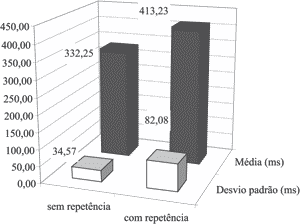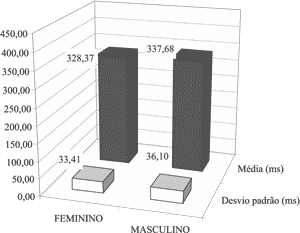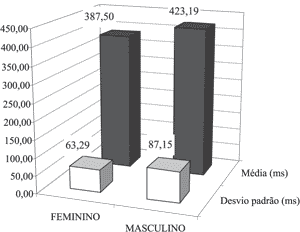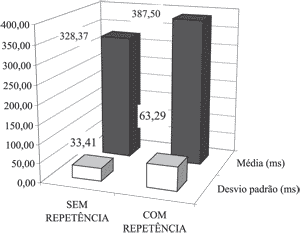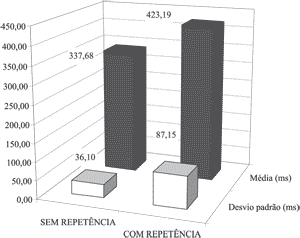

Year: 2004 Vol. 70 Ed. 2 - (8º)
Artigo Original
Pages: 194 to 199
P300: electrophysiological avaliation of hearing in children who have never repeated and who have repeated at school
Author(s):
Luciane S. Farias 1,
Ivone F. Toniolo 2,
Pedro L. Cóser 3
Keywords: audiology, P300, children
Abstract:
Aim: This research was done with the objective to compare the values of latency of P300 in male and female kids 8 to 13 years of age, who have repeated at least a semester and who have not repeated any semester at school. Study design: Clinical study with transversal cohort. Material and Method: Sixty kids who have never flunked at school and 43 kids who have already flunked were examined in public schools in Santa Maria. All kids were submitted to an anamnesis, pure tone audiometry, tympanometric curve, contra lateral reflexes auditory and P300. Results and Conclusion: At the end of this research it can be concluded that kids that have not repeated any year at school presented mean arithmetic latency value of P300 lower (332,25 ms), when compared to kids that have repeated (413,23 ms). Female children of the group that has no failure history at school have presented a mean arithmetic latency value of P300 lower (328,37 ms) than male kids (337,68 ms) of the same group. In the group of kids with failure history, the female kids have also shown mean arithmetic latency value of P300 lower (387,50 ms), compared to the male kids (423,19 ms). Finally lower mean arithmetic values of latency of P300 were observed in the group of both female (328,37 ms) and male kids (337,68 ms) who have not repeated at school when compared to the mean arithmetic values of latency of P300 in female (387,50 ms) and male kids (423,19 ms) who have repeated at school.
![]()
INTRODUCTION
In order to have perfect hearing, all components of the hearing system, from external ear to auditory cortex, should be properly working.
Auditory integrity is essential in human sensorial system, since hearing plays an important role in language acquisition and development, effectively contributing to the learning-teaching process.
The definition of hearing levels in school children was the objective of many propositions of intervention in the area of educational speech and hearing pathology, since hearing plays a key and decisive role in communication. It is necessary, therefore, for children to have integrity of the auditory system both at peripheral and central levels.
Central auditory processing disorders involving auditory skills, such as location, attention, figure-ground, memory, discrimination, auditory analysis and synthesis can be present in children with school learning difficulties.
In some cases, audiological assessment in children with complaints of understanding demonstrates that peripheral hearing is within the normal range, but behavioral and electrophysiological tests evidenced central auditory system disorders.
Since the first studies related to long latency evoked auditory potentials, P300, conducted by Sutton, Braren, Zubin (1965), Sutton, Tueting, Zubin (1967), many studies have been conducted to improve the knowledge related to auditory information processing.
These studies have investigated processing of information involving special skills, such as auditory attention and discrimination, whose analysis is made from receptor, transmission pathways, up to cortical areas in which the impulses are integrated (Luccas, Manzano, Ragazzo, 1983).
The exact location of P300 origin is still unknown. Some studies were conducted in order to find the location of areas that originate it (Wood et al., 1980; Halgren et al., 1980). The specific discovery of these areas can contribute to the topographic diagnosis of the lesions that affect central auditory processing.
Among the different audiological procedures in which we assess the central auditory integrity we can include information obtained by auditory evoked potentials. They, in turn, play a key role in audiology, since the capacity to collect electrical potentials created in many different levels of the nervous system as a response to acoustic stimulation, without using invasive techniques, is a great advance in the diagnosis of auditory pathologies.
Among long latency auditory potentials, we can include P300, whose responses reflect auditory attention and discrimination related to cognitive capacity of children. Studies have demonstrated that P300 values of latency are reliable and there is no significant different between test and retest (Skalare & Lynn, 1984).
The purpose of the present study was to compare the latency values P300 in children aged 8 to 13 years, both female and male, who had or had not failed school.
MATERIAL AND METHOD
The sample of the study comprised female and male children aged between 8 and 13 years who went to elementary state-owned schools in the city of Santa Maria, RS. Children were distributed in two groups: one group of 60 children who had not failed school and presented satisfactory performance, being 25 male and 35 female children, and another group of 43 children who failed school and presented dissatisfactory school performance, being 31 male and 12 female children.
We adopted minimum age of 8 years owing to the fact that most of the children below the age of 8 were not capable of responding to P300 test according to the chosen methodology, that is, mental counting of rare stimuli.
Initially, we conducted anamnesis, considering data on pregnancy, psychomotor development, school performance, hearing and other diseases. Later, we conducted inspection of external auditory canal and hearing tests, such as pure tone audiometry in frequencies of 250 to 8000Hz, and speech tests such as speech discrimination index and speech recognition threshold, plus tympanometric curve and contralateral reflexes. The inclusion criteria in the sample were to have thresholds below or equal to 15dB HL (Northern & Downs, 1989), type A tympanogram and acoustic reflexes (Jerger, 1970).
In order to assess P300 the child was positioned on a comfortable and reclining chair, we proceeded with cleaning of skin and scalp with abrasive paste and common gauze. Right after it, we placed silver electrodes with electrolytic paste and adhesive tape on the right mastoid (A1) - grounding; left (A2) - reference; and vertex (CZ), on the scalp. The electrodes connected to a pre-amplifier fixed to the children's clothes should not have had impedance values higher than 5 . Next, we conditioned the children to make the task, that is, mentally count the rare stimuli.
The auditory stimuli used were binaural tone burst and 20 ms plateau and rise-fall of 5 ms, with frequencies of 1000Hz for frequent stimuli and 3000Hz for rare stimuli, with intensities of 80dB HL for both. In each test we presented 300 stimuli, 240 frequent stimuli and 60 rare stimuli, that is, 80% frequent and 20% rare (Goodin et al., 1994). Polarity was alternated, rhythm of presentation of stimuli occurred at regular intervals of 1 per second and the filter used was 0.5 to 20 Hz. The window used was 750 ms. Auditory stimuli were presented in series of 300 stimuli each, in order to confirm the value of latency.RESULTS
Graph 1. Arithmetic mean and standard deviation of P300 latency in both groups.
Graph 2. Linear regression of P300 latency as a result of the age of the group of children who did not fail school.
Graph 3. Arithmetic mean and standard deviation of P300 latency by gender in the group of children who did not fail school.
Graph 4. Arithmetic mean and standard deviation of P300 latency by gender in the group of children who failed school.
Graph 5. Arithmetic mean and standard deviation of P300 latency in female gender in the group of children who failed or not school.
Graph 6. Arithmetic mean and standard deviation of P300 latency in male gender in the group of children who failed or not school.
DISCUSSION
Analysis of P300 latency values according to age in the group of children who had failed or not school
The statistical analysis of the results of the study of the group of children who did not fail school showed non-significant dependency between variables age and latency of P300, demonstrated by Pearson's correlation coefficient. In the calculation of this correlation, in the group of children aged 8 to 13 years without school failure, we found R=-0.10, that is, non-significant decreasing dependence. It means that dependency of variables age and latency exists, but it is not representative. Upon comparing these results with those by authors such as Pearce et al. (1989), it was observed that they found strong decreasing dependence between variables age and latency (R=-0.62), in a group of 35 children aged 5 to 13 years. Thus, the results of this study differ from those found by other authors.
Considering the lack of statistically significance with variables age and latency previously chosen, we decided to calculate the arithmetic mean and standard deviation for the total number of children without school failure, whose values found were 332.25ms and 34.57 ms, respectively. Some authors, such as Visioli-Melo & Rotta (2000), found similar values for arithmetic mean and standard deviation of P300 latency, 336 ms and 53 ms, respectively, upon studying a sample of 32 children with good school performance. Other authors studied the values of arithmetic mean and standard deviation of P300 latency in children and respectively found the following values: Jirsa & Clontz (1990) 315 ms and 35.70 ms; Jirsa (1992) 320 ms and 32.80 ms; Aquino et al. (2000) 305.71 ms and 4.76 ms. Upon checking the presence of dependency between variables age and latency, using Pearson's correlation coefficient, even though non-significant, a linear regression analysis was conducted in order to define the estimate of latency values per age, evidencing that this estimate is the exclusive result of latency values of P300 in the sample of children who did not fail school. In the calculation of linear regression in the group of children without school failure, we found the equation Y = -2.03 X + 353.58, evidencing a decreasing trend of -2.03ms per year, that is, upon increasing age, latency decreases. Finley et al. (1985) studied linear regression of latency P300 in 39 children and normal young adults, aged 5 to 17 years, and they found an equation for linear regression of Y= -3.6 X +358. Even though age ranges used by the authors had been wider, the value of linear regression was very close to the one found in our present study. Other studies using linear regression of P300 showed higher values for the decrease of latency by age. Goodin et al. (1978) detected a decrease of -18.4ms per year in children aged 6 to 15 years, increasing 1.8ms per year from then on; Martín et al. (1988) and Barajas (1990) observed in children aged 6 to 14 years, a decrease of -19ms per year up to 15 years; Pearce et al. (1989) analyzed children aged 5 to 13 years and found a tendency of decrease of -20.34ms per year. There is evidence that the difference in values between the coefficient of inclination of linear regression in the literature and the value of coefficient of inclination found in the present study (-2.03ms per year) could be resultant from the variation of age ranges addressed by the authors and also by the methodology used to obtain responses from P300. When we tried to assess, at the beginning of the study, children below the age of 8 years, we noticed that most of them were not capable of answering appropriately to the P300 test according to the methodology used, that is, mental counting of the rare stimuli. We did not allow counting with the fingers, since we believe that each methodology can result in different measures of P300 latency, according to Lew & Polich (1993) and Cezar & Munhoz (2002). In order to check the level of dependency of the quantitative variables of age and latency in the group of children who failed school, we calculated Pearson's correlation coefficient, and we found R= -0,03, that is, decreasing non-significant dependency. It means that the dependency on the variables is also non-significant in the group, such as in children who had not failed school. Considering the calculation of Pearson's coefficient, in which we detected non-significant dependency of variable P300 latency as a result of age in the group of children who failed school, we determined the arithmetic mean of 413.23ms and standard deviation of 82.08ms for all the children in the group who failed school. In the studied literature, we detected that some authors studied children who had school difficulties and found values greater than the arithmetic mean and standard deviation of those obtained in this study, such as Jirsa & Clontz (1990), 429 ms and 108.70 ms, for 18 children aged 9 to 11 years, and Jirsa (1992), 438 ms and 124.90 ms, for 10 children aged 9 to 12 years. However, Visioli-Melo & Rotta (2000) found values of arithmetic mean and standard deviation of P300 latency lower than the present study, 382 ms and 57 ms, respectively, in 32 children aged 10 to 11 years.
Focusing on the purpose of the present study, which was to compare latency values of P300 in children aged 8 to 13 years who did or did not fail school, we parallely showed mean values and standard deviation found in the groups of children that did not fail school, 332.25ms and 34.57ms, respectively, and in the group who failed school, 413.23ms and 82.08ms, in which we detected that arithmetic mean and standard deviation of values of P300 latency in the group of children who failed school were higher. Authors such as Jirsa & Clontz (1990), Jirsa (1992), Diniz (1996), Visioli-Melo & Rotta (2000) also found increased latency values of P300 in children who had poor school performance, when compared to children with good school performance.
Children that failed school presented latency values of P300 greater than P300latency values in children that had not failed. It means that time in milliseconds between the presentation of a rare stimulus and the response of P300 is greater in the group of children who failed school, that is, in these children the P300 response takes longer to be given, evidencing slower cortical response (Diniz, 1996). In order to check whether the existing differences between the studied groups were statistically significant concerning behavior of variable latency of P300, we applied non-parametric Kolmogorov-Smirnov test. In this aspect, the results of the study showed there were significant differences between the two groups, that is, latency of P300 behaved differently in each analyzed group.
The comparative analysis between the groups of children aged 8 to 13 years that did not fail school and those that failed it is in accordance with the proposition made by Franco (2001), where he referred to P300 as a tool to compare two groups of similar formation but in which there are characteristics that we want to statistically test.
Analysis of P300 latency values according to gender in the group of children who failed or not school
We separated the groups of children who did not fail and those who failed school to check the behavior of P300 latency as a result of variable of gender.
To check the behavior of P300 latency as a result of qualitative variable gender in the group of children who did not fail school, we calculated mean and standard deviation values of male and female genders: 337.68ms and 36.10ms; and 328.37 ms and 33.41 ms, respectively. Thus, we obtained lower values for arithmetic mean and standard deviation in the female group of children.
We also applied non-parametric statistical tests of Kolmogorov-Smirnov in order to check the behavior of latency of P300 among female and male children in the group who did not fail school. We can state that, concerning latency values of P300 in female children compared to latency values obtained in male children, they were different populations. Martín, Barajas & Fernández (1988), Martin et al. (1993), Frizzo et al. (2001) did not find statistically significant difference between values of P300 latencies when comparing the variable gender.
In order to conduct a more precise investigation of latency P300 behavior in the group of male and female children who failed school, we calculated the arithmetic mean and standard deviation and reached the values 387.50ms and 63.29ms for female children, and 423.19 ms and 87.15ms for the group of male children. We detected lower values for the female group of children.
Next, we used non-parametric statistical test of Kolmogorov-Smirnov to check whether there would be any significant difference concerning qualitative variable of gender and quantitative variable of latency, which demonstrated there was no significance, that is, we cannot state that they are different population, since we did not find correlation between latencies and genders.
To perform a more precise comparison in the study, we compared the groups who failed or not school, investigating initially only qualitative variable female gender, which demonstrated lower values than the arithmetic mean and standard deviation of latency in P300 in the group without school failure, with 328.37ms and 33.41ms, respectively. In the group of female children who failed school, the values were 387.50ms and 63.29ms, respectively.
In order to investigate whether this difference presented by female children in the group who did not fail school was significant comparing to female children in the group who failed school, we applied the statistical tests of Kolmogorov-Smirnov, which demonstrated significant difference between female gender in both groups, meaning that they were different populations.
Finally, similarly to the girls, we analyzed arithmetic means and standard deviation in the male group of children who failed or not school and we found values of 337.68 ms and 36.10 and 423.19 and 87.15 ms, respectively. It was observed that the group of male children without school failure presented lower values than male children who had failed school.
Aiming at investigating the difference presented by male children in both groups, we used once again statistical test by Kolmogorov-Smirnov, in which we concluded there was difference between male children, forming two different groups of population.
CONCLUSION
1. The group of children who had not failed school presented lower values of P300 latency compared to the children who had failed school;
2. Female children in the group who failed school presented lower values of P300 latency compared to male children who had not failed school;
3. Female children who had not failed school presented lower latency values of P300 than the female group of children who had failed school;
4. Male children in the group who had not failed school presented lower P300 latency values, compared to the children in the male group who had failed school;
5. There was no statistically significant difference between P300 latency values comparing female and male children who had failed school.
REFERENCES
1. Aquino A, Bardão R, Barbosa M, Colafêmina J et al. Potencial endógeno nos distúrbios da atenção e memória. São Paulo. Revista Brasileira de Otorrinolaringologia 2000 mai/jun; 66(3): 225-30.
2. Barajas J. The effects of age on human P3 latency. Acta Otolaryngol 1990 (suppl.) 476:157-60.
3. César CPHAR, Munhoz M. O P300 auditivo em jovens e adultos saudáveis com uma nova proposta de resposta: levantar a mão. Acta Awho 2002; 32-7.
4. Diniz JJ. Contribuição ao estudo do potencial evocado auditivo de longa latência em crianças. Dissertação (Mestrado em Otorrinolaringologia) - UNIFESP - Escola Paulista de Medicina São Paulo. 1996.
5. Finley WW, Faux SF, Hutcheson J et al. Long-latency event-related potentials in the evaluation of cognitive function in children. Neurology 1985; 35(3): 323-7.
6. Franco GM. O potencial evocado cognitivo em adultos normais. Arquivo de Neuropsiquiatria 2001; 59 (2-A): 198-200.
7. Frizzo ACF, Alves RPC, Colafêmina JF. Potenciais auditivos de longa latência: um estudo comparativo entre hemisférios cerebrais. Revista Brasileira de Otorrinolaringologia 2001 set/out; 65(5): 618-25.
8. Goodin DS, Squires KC, Hendersonb H, Starr A. Age-related variations in evoked potentials to auditory stimuli in normal human subjects. Eletroencephalography and Clinical Neurophysiology 1978; 447-58.
9. Goodin D, Desmedt J, Maurer K & Nuwer MR/IFCN (International Federal of Clinical Neurophysiology) Recommended standard for long-latency auditory event-related potentials. Eletroencephalography and Clinical Neurophysiology 1994; 91(1):18-20.
10. Jerger J. Clinical experience with impedance audiometry. Arch Otolaryng 1970; 92: 311-24.
11. Jirsa R, Clontz K. A long latency auditory event related potentials from children with auditory processing disorders. Ear and Hearing 1990; 222-32.
12. Jirsa R. The children utility of the P3 AERP in children with auditory processing disorders. Speech and hearing research 1992; 903-12.
13. Lew G, Polich J. Habituation and response mode. Physiology and Behavior 1993; 111-7.
14. Luccas FJ, Manzano GM, Ragazzo PC. Potencial evocado: generalidades. Arquivo Brasileiro de neurocirurgia 1983; 65-70.
15. Martín J, Barajas J, Fernández R. Auditory P3 development in childhood. Scandinavian Audiology 1988 (supl.) 30: 105-9.
16. Martin F, Delpont E, Suisse G et al. Long latency event-related potentials (P300) in gifted children. Brain and development 1993; 173-7.
17. Northern JL, Downs MP. Audição em crianças São Paulo: Manole; 1989. cap.l:11.
18. Pearce JW, Crowel DH, Tokioka A et al. Childhood developmental changes in the auditory P300. Journal of child neurology 1989; 100-6.
19. Skalare DA, Lynn GE. Latency of the P3 event-related potential: normative aspects and within-subject variability. Eletroencephalography and Clinical Neurophysiology 1984; 420.
20. Sutton S, Braren M, Zubin J. Evoked potential correlates of stimulus uncertainty. Science 1965; 150: 1187-8.
21. Sutton S, Tueting P, Zubin J. Information delivery and the sensory evoked potential. Science 1967; 155: 1436-9.
22. Visioli-Melo JF, Rotta NT. Avaliação pelo P300 de crianças com e sem epilepsia e rendimento escolar. Arquivo de Neuropsiquiatria 2000 jun; 58(2B): 476-84.
23. Wood CC, Allison T, Goff WR et al. On the origin of P300 in Man. Prog Brain Res 1980; 51-6.
1 Speech and Hearing Therapist, Master in Human Communication Disorders.
2 Speech and Hearing Therapist, Ph.D. in Human Communication Disorders.
3 Otorhinolaryngologist, Ph.D. in Human Communication Disorders.
Address correspondence to: Av. Fernando Ferrari 1220/401Santa Maria RS
E-mail: luciane@infoway.com.br
Study presented at Federal University of Santa Maria as Master Dissertation on December 18, 2002 in Santa Maria-RS.
